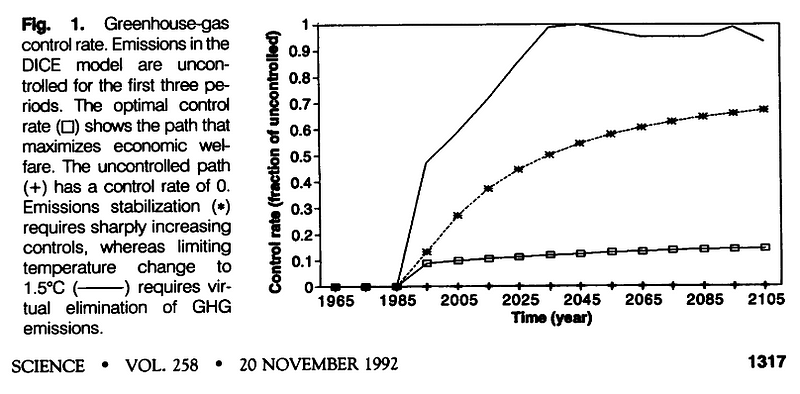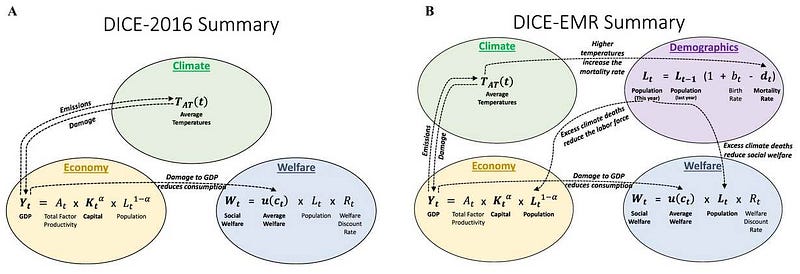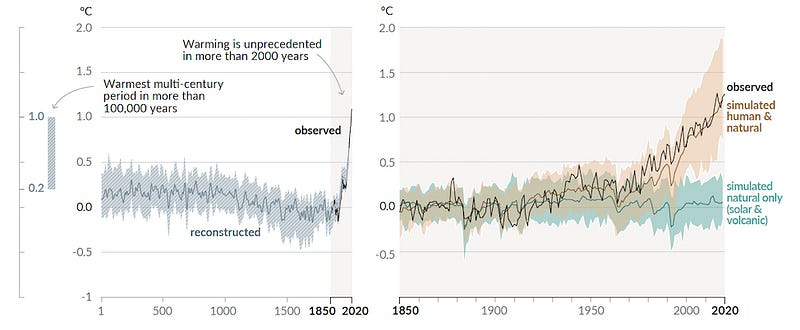The Great Pause Week 74: The Cost of Climate Solutions
"We may not have noticed that we are borrowing from our children. Our children have noticed."\
 |
Some of the future occupants of 160 unmarked graves found at Kuper Island School, B.C., operated from 1890 to 1975 by the Missionary Oblates of Mary Immaculate |
All of the books I have written about climate change — Climate in Crisis, Post-Petroleum Survival Guide, The Biochar Solution, Burn — have had sections on money somewhere towards the conclusion. That is because a real solution requires system change and money is at the heart.
The best things in life are free
But you can keep them for the birds and bees
Now give me money
That’s what I want
— Money (That’s What I Want), 1959 by Berry Gordy Jr, Janie Bradford, Motown Records
A paper published in the journal Nature Communications July 29 tried to calculate the present cost of climate change. Unlike earlier attempts, the author, R. Daniel Bressler of Columbia University Center for Environmental Economics and Policy, calculated the numerator first in deaths, not dollars. The denominator is lifestyle.
One per 3 point 5
The lifetime emissions at 2020 levels of 3.5 North Americans will result in one additional heat-related death in this century, most probably in the global South. The worldwide average is 12.8 modern, carbon-intensive lifestyles to cause that single death.
The new research also shows the stark difference between personal carbon footprints and the kind of change that can be achieved through actions at the scale of government and business. Having calculated that 4,434 metric tons of carbon dioxide added to the atmosphere would result in one death during this century, Mr. Bressler said that simply taking one coal-fired power plant offline and replacing it with a zero-emissions alternative for just one year, would result in a “mortality benefit of saving 904 lives” over the century. “That would be a lot more impact than a personal decision,” he said.
— The New York Times July 29, 2021
One per 3.5 is akin to an average US family having a slave brought into their home from some distant colony. Once that slave has provided the family the lifestyle to which they are accustomed, he/she is quietly disposed of, like a native child at a 20th Century Canadian Residential School.
In 1992, PNAS published a paper by Nobel laureate economist William Nordhaus, “An optimal transition path for controlling greenhouse gases.” Nordhaus was a climate moderate, advocating a graduated carbon tax and abjuring “rigid emissions or climate-stabilization approaches.” His dynamic optimization model, or DICE, factored the social and economic costs of change against his perceived, albeit nearsighted, costs of staying the course. The 1992 paper ran through five scenarios:
- Business as usual meant that no controls would be imposed and humans would simply adapt.
- Optimization meant that reductions would come by policy changes starting in 1990 and hold warming to 1.5°C. Nordhaus said that could be accomplished with a net economic benefit of $199 billion (1989 dollars) per year.
- Emissions stabilization to, say, 1990 levels, would come at a cost. While rejected by the US delegation at Rio in June 1992, this would later be adopted at COP-3 in Kyoto in 1996. Nordhaus said stabilization implied reduction of emissions to 8 GtC (29 GtCO2-e), or approximately 75% of present. He said it offered simplicity at the expense of scientific and economic merit.
- Climate stabilization is a more ambitious approach and the one later made law in Paris in 2015. To Nordhaus it required slowing warming by 0.2°C per decade after 1985, capping at 1.5°C from the 1900 benchmark. While he was reasonably accurate on his estimates, Nordhaus considered this approach foolhardy.
- Geoengineering is what he found to be the most promising, if controversial. He conceded that that it would first need to be proven technically feasible and economically and environmentally benign, but he well understood the discount rate for technological innovation and Moore’s Law. He estimated any climate solutions expenditure less than $4.1 trillion would create a net savings, which is remarkably insightful for 1992. He estimated that spending that much would mean adding less than 1% to the costs of goods in the future (which he termed, “discounted consumption”).
In Nordhaus’s optimization path, the world (coordinated by the UN or some other organization such as the Global Economic Forum) would adopt a carbon tax of $5 per ton from 1990, gradually rising to $20 by 2100. Alternatively, if the world went for the simplistic approach of emissions stabilization, we would need a CO2 tax of $100/ton early in the 21st century, reaching around $800 in the second half, which Nordhaus equated to a tax of $7 per ton of coal and 80 cents per barrel of oil, bringing in about $3 trillion/yr in revenues.
The Nordhaus model — the “Dynamic Integrated Climate-Economy,” or DICE — pegged the social cost of CO2 at about $37 per metric ton. The Obama administration estimated $50 per ton, but the Trump administration cut that to as little as $1. The Biden administration is working on its own social cost of carbon, expected early next year; a preliminary figure released in February roughly matched Obama’s.
Nordhaus updated his model in 2016 and arrived at $31.2 per ton of CO2 for emissions in 2015, with the value rising at 3% per year in real terms to $88/t in 2050. That was for a 2-degree limit that Nordhaus believed could still be attained through negative emissions. Slipping the target to 2.5 degrees meant that social costs would climb to $184 per tCO2. Multiply 42 gigatons times $184 and you have an annual social cost of $7.7 trillion, although I don’t think you would find any Maldive Islanders or residents of Lytton BC willing to put a price on their ancestral homes.
Swiss Re estimates that insured losses from catastrophes in the first half of this year topped $42 billion. Uninsured losses are incalculable.
Daniel Bressler updated Nordhaus’ DICE estimate of the social cost of CO2 to $258 per metric ton. This is not the highest estimate out there. Various international agencies and non-governmental organizations have attempted to calculate the subsidies being paid to fossil industries. According to the International Monetary Fund, the world subsidizes fossil fuels to the tune of $6 trillion per year (~$600 per carbon ton). This is what we currently pay the Exxons and Aramcos of the world to pollute, beyond the usual $1000 per ton refiners pay them for their products.
Nordhaus’ benefits side of the equation has also been updated. At the 2020 World Economic Forum it was reported that carbon capture technologies will realize $1 trillion to $3 trillion dollars in market opportunities and another $3 trillion to $5 trillion in broader economic, social and environmental benefits per year by 2030. Nordhaus didn’t think that a $3 trillion benefit would be reached before the end of this century.
In my view, enhanced photosynthesis in combination with carbon conversion to biochar and bio-oils is the best value proposition, can mobilize philanthropy and government incentives in the early stages, and then be driven by the market. Biochar does not require a high peg per carbon ton because it is already profitable and anything that comes its way from selling carbon credits is gravy. It’s a disruptive technology already.
Infanticidal Cults
My own thought exercises in this area began in 1988, while I was working on Climate in Crisis and after I had interviewed a number of climate scientists who had been thinking along similar lines. I will take up that discussion and go through Contraction and Convergence, Cap and Share, Fee and Dividend, and finally the carbon tax legislation now moving through the US Congress when I pick up this thread again in the next installment.
We are living wastefully, but we have been insulated from the consequences because we have begun to spend Earth’s capital as if it were income. We may not notice that we are borrowing from our children. Our children will notice.
… And so may that slave that every one of our families is holding, praying their death sentence will be overturned. In the Canadian Residential Schools —and make no mistake, the US and Australia had them also — the death penalty was doled out to reluctant or tardy children who would not quickly convert from carbon-balanced lifestyles to climate-altering consumerism. The death penalty for failing to make the reverse conversion is the new normal for the rest of us.
References
Draper, K., 2016. The Biochar Displacement Strategy, Biochar Journal Nov 2016,
Nordhaus W.D., 1992. An optimal transition path for controlling greenhouse gases. Science 258(5086):1315–1319.
Nordhaus, W.D., 2017. Revisiting the social cost of carbon. Proceedings of the National Academy of Sciences, 114(7), pp.1518–1523.
Schwartz, J., 2021. A Carbon Calculation: How Many Deaths Do Emissions Cause? The New York Times. July 29, 2021, Updated Aug. 5, 2021.
___________________________
As the world confronts the pandemic and emerges into recovery, there is growing recognition that the recovery must be a pathway to a new carbon economy, one that goes beyond zero emissions and runs the industrial carbon cycle backwards — taking CO2 from the atmosphere and ocean, turning it into coal and oil, and burying it in the ground. The triple bottom line of this new economy is antifragility, regeneration, and resilience.
Help me get my blog posted every week. All Patreon donations and Blogger subscriptions are needed and welcomed. You are how we make this happen. Your contributions are being made to Global Village Institute, a tax-deductible 501(c)(3) charity. PowerUp! donors on Patreon get an autographed book off each first press run. Please help if you can.
#RestorationGeneration
“There are the good tipping points, the tipping points in public consciousness when it comes to addressing this crisis, and I think we are very close to that.”
— Climate Scientist Michael Mann, January 13, 2021.
Want to help make a difference while you shop in the Amazon app, at no extra cost to you? Simply follow the instructions below to select “Global Village Institute” as your charity and activate AmazonSmile in the app. They’ll donate a portion of your eligible purchases to us.
How it works:
1. Open the Amazon app on your phone
2. Select the main menu (=) & tap on “AmazonSmile” within Programs & Features
3. Select “Global Village Institute” as your charity
4. Follow the on-screen instructions to activate AmazonSmile in the mobile app







Comments